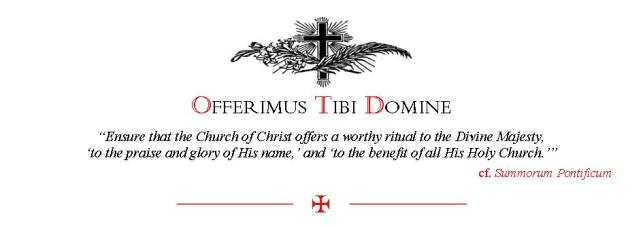 There is an excellent blog at THE CHANT CAFÉ : www.chantcafe.com/2011/01/mutual-enrichment-and-reform-of-reform_10.html?utm_source=feedburner&utm_medium=feed&utm_campaign=Feed%3A+TheChantCaf+%28The+Chant+Caf%C3%A9%29
There is an excellent blog at THE CHANT CAFÉ : www.chantcafe.com/2011/01/mutual-enrichment-and-reform-of-reform_10.html?utm_source=feedburner&utm_medium=feed&utm_campaign=Feed%3A+TheChantCaf+%28The+Chant+Caf%C3%A9%29
It’s talking about the mutual enrichment of the two forms of the Roman Rite - the old and the new. The question it addresses is: What does this actually mean and how might it play out in the future? I’ve often wondered myself quite what, in practical terms, the Holy Father had in mind when saying that the two forms could enrich one another but at the same time stressing that we could not “mix and match” at will. Obviously, the style - the ars celebranda - and physical setting can be imported very easily from the more traditional to the modern.
Listed first the move to de-focus the personality of the individual priest by the adoption of the ancient but now revolutionary ad orientem or facing the altar position. From my own perspective (which is facing the Lord on the altar) it is this which above all begins to change attitudes. As for all the other points in the envisaged “first stage” of mutual enrichment - I’ve been doing them all (or trying to) for some years now.
The only extra point that I thought might be included is the possibility in the future of finding a way to offer the Traditional Form with incense and congregational singing where a parish simply does not have the resources to sing the Introit, Gradual, Offertory and Communion. This can be done at the moment by offering Low Mass with hymns but the priest cannot sing the Collects and incense cannot be used. (Although this point is brought up in the comments on the original blog).
All in all, though what might happen in the future is obviously unknown, the “first stage” can be implemented by everyone right now without any change in rubrics or legislation.
Do read the other points on the two way direction of the enrichments at the blog.










1 comment:
I left the follwoing comment on the blog to which you directed us Father. I offer it here in case it is of any interest to you.
If we are to see the two Forms mutually enriching one another then Rome must give some direction as to how this is to be done in that mixing the Forms is forbidden to all of us, be we of Presbyteral and Episcopal rank. Currently my own attempt is limited to celebrating all Masses ad orientem; the singing the Sanctus, Pater Noster and Agnus Dei of the OF in Latin, and the use of vernacular readings in the EF. In both Forms I encourage reception on the tongue while kneeling, without refusing Communion in the hand where its use is permitted. Silence in Church before and after Mass has also gone a long way to establishing respect for the sacred liturgy and the Blessed Sacrament.
Perhaps to establish the Reform of the reform Rome may simply need to establish
1. a single calendar for both the ordinary and Extraordinary Forms
2. the restoration of the (and still rubrically directed) ad orientem/altar facing position in the OF
3. the restoration of Communion on the tongue while kneeling, which is still the Church’s official norm; reception on the hand being allowed only by the granting of the necessary indult (permission)
4. the restoration of the genuflections before the elevations and the Per ipsum
5. the use of the EF Offertory Prayers in the OF (they clearly prepare the Sacrifice while the OF Preparation of the Gifts prayers do not; they come from a Jewish Grace before meals which somehow gives lie to the central reality of the Eucharist as a Body given up and a Blood which is shed)
Individual parishes could be encouraged to establish small choirs or even a cantor who can sing the antiphons of the Propers. Indeed, the singing of hymns in either Form is not approvingly envisaged; they have the very lowest rank of approval even in the OF (cf. Musicam sacram, 1967) and have made even the OF into a ‘hymn sandwich’ type of liturgy in most places.
To my knowledge the Prayers at the Foot of the Altar where never part of the Dominican Rite prior to Vatican II, but seem to have a significant part to play in terms of theology and symbolism in that they allow the priest and people to make their Confession of sinfulness and plea for mercy before they enter the holy of holies. In the OF one enters the sanctuary immediately and as if by right, not by mercy; only then does one Confess and make one’s plea for mercy.
Fr Gary Dickson
Post a Comment